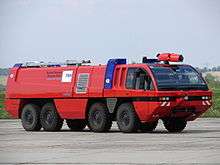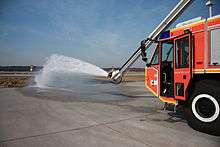Airport crash tender



An airport crash tender (known in some countries as an airport fire appliance) is a specialised fire engine designed for use in aircraft rescue and firefighting at aerodromes.
Description
Airport crash tenders are extremely powerful machines. They offer relatively good acceleration (for such large, heavy vehicles), are able to negotiate rough terrain outside the airport area, carry large capacities of water and fire fighting foam, are fitted with powerful high-capacity pumps and water/foam cannons, and are capable of delivering firefighting media over long distances. They can be mounted on 4x4, 6x6 or even 8x8 wheeled chassis. In order to decrease their turning radius, the 8x8 wheeled unit may have all 4 wheels at the front of the vehicle involved in turning the truck.
Newer airport crash tenders also incorporate twin agent nozzles/injection systems to inject a stream of Purple-K dry chemical into the AFFF foam stream "knocking-down" the fire faster. Some also have Halotron tanks with handlines for situations that require a clean agent to be utilized. These features give the airport crash tenders a capability to reach an airplane rapidly, and rapidly put out large fires with jet fuel involved.
Some tenders have an elevated extended extinguishing arm, giving a possibility to raise a water/foam cannon into the height of approx. 10 – 20 meters, that can puncture through superficial structures of an aeroplane to fight a fire inside the fuselage.[1]
Some arms have reinforced nozzles, called a snozzle, that, according to the US National Transportation Safety Board is a "piercing nozzle on the fire truck that is used to penetrate an airplane's fuselage and dispense AFFF to extinguish fire inside the cabin or cargo area."[2]
Standards
The International Civil Aviation Organization (ICAO) has given standards and recommended practices on rescue fire fighting categories of civil aerodromes.[3][4][5] National aviation authorities may have given even further requirements on aerodrome rescue and fire services.
The rescue fire services are based on a critical aircraft based on a statistical analysis of movements (take-offs and landings) on the airport. The aerodrome category is based on the size of the biggest aircraft taking a movement on the aerodrome. In addition, the number of movements of the critical aircraft is calculated, and the category can be decreased by one if the number of movements is lower than the standard describes. For example, at an airport regularly handling Boeing 737 and Airbus A320 aircraft with a single Boeing 777 service per week, the airport fire service has to cater up to the ICAO category 7 of the 737 and A320; a single 777 movement per week does not justify a full ICAO category 9 fire service. There are also minimum category levels based on e.g. the number of seats in the critical aircraft.[6]
Depending on the airport category, the standards determine the minimum number of rescue fire-fighting vehicles. In addition, requirements are given on the water and foam capacities, discharge rates for foam solutions, and minimum dry chemical powder (complementary agent) amounts, reserve stocks of fire fighting agents, ability to operate on rough terrain, and acceleration of the air crash tenders. The end of each runway has to be achieved in a response time of two minutes, and any part of the movement area has to be achieved in a response time not exceeding three minutes.
Range of airport firefighting vehicles
Airport rescue and firefighting services operate many specialist vehicles to provide emergency cover at airports. They include:
1) Crash tenders (as described above)
2) "Domestic" type fire appliances. Domestic appliances are similar in function and appearance to fire appliances operated by county fire services / departments. They are not as large or as heavy as airport crash tenders. The units are ordinarily used to respond to fire incidents in airport terminal buildings but also respond to aircraft incidents. The appliances carry Breathing Apparatus, rescue equipment, firefighting media, ladders, cutting equipment.
3) "First attack" or "rapid intervention vehicles"(RIV). RIVs are normally smaller, nimble fire appliances capable of quick acceleration and high speed. They carry less equipment than Domestic and Crash Tenders but arrive first on scene at aircraft incidents to begin rescue and firefighting operations whilst heavier / larger units approach.
4) General purpose vehicles (such as a fire chief's car or general purpose or incident support vehicles).
See also
| Wikimedia Commons has media related to Airport crash tenders. |
- Oshkosh Striker - specific model of Crash Tender manufactured by the Oshkosh Corporation
- Water salute
References
- ↑ Relyea; Robert G., Garnett; Edward V.: United States Patent Application, February 8, 1993. http://patft.uspto.gov/netacgi/nph-Parser?patentnumber=5301756
- ↑ NTSB
- ↑ ICAO: Volume 1 - Aerodrome Design and Operations. Annex 14: Aerodrome Rescue and Fire Fighting Service (RFFS) requirements
- ↑ ICAO: Airport Services Manual. Part 1 - Rescue and Fire Fighting. 3rd edition, 1990
- ↑ Find relevant ICAO standards and recommended practices on SKYbrary
- ↑ Categories for Fire Fighting and Minimum Fire Fighting Capacity